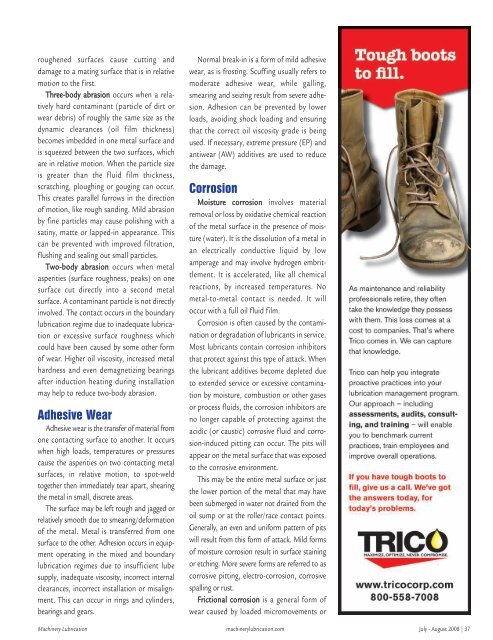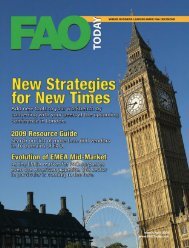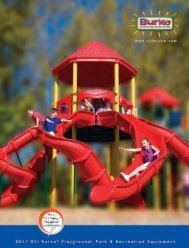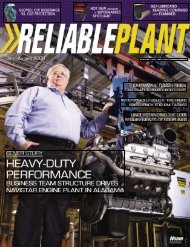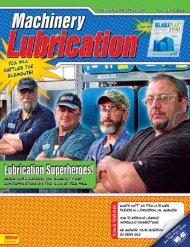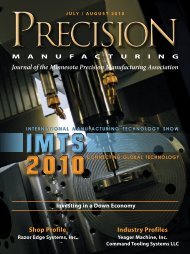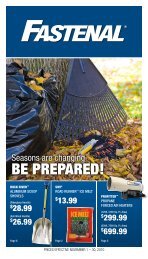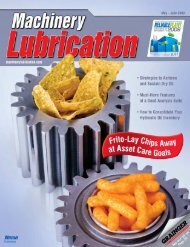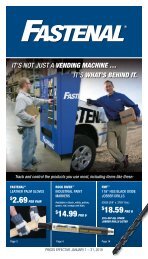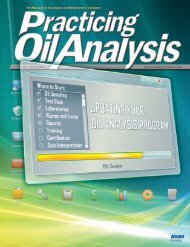Machinery Lubrication July August 2008
Machinery Lubrication July August 2008
Machinery Lubrication July August 2008
Create successful ePaper yourself
Turn your PDF publications into a flip-book with our unique Google optimized e-Paper software.
oughened surfaces cause cutting and<br />
damage to a mating surface that is in relative<br />
motion to the first.<br />
Three-body abrasion occurs when a relatively<br />
hard contaminant (particle of dirt or<br />
wear debris) of roughly the same size as the<br />
dynamic clearances (oil film thickness)<br />
becomes imbedded in one metal surface and<br />
is squeezed between the two surfaces, which<br />
are in relative motion. When the particle size<br />
is greater than the fluid film thickness,<br />
scratching, ploughing or gouging can occur.<br />
This creates parallel furrows in the direction<br />
of motion, like rough sanding. Mild abrasion<br />
by fine particles may cause polishing with a<br />
satiny, matte or lapped-in appearance. This<br />
can be prevented with improved filtration,<br />
flushing and sealing out small particles.<br />
Two-body abrasion occurs when metal<br />
asperities (surface roughness, peaks) on one<br />
surface cut directly into a second metal<br />
surface. A contaminant particle is not directly<br />
involved. The contact occurs in the boundary<br />
lubrication regime due to inadequate lubrication<br />
or excessive surface roughness which<br />
could have been caused by some other form<br />
of wear. Higher oil viscosity, increased metal<br />
hardness and even demagnetizing bearings<br />
after induction heating during installation<br />
may help to reduce two-body abrasion.<br />
Adhesive Wear<br />
Adhesive wear is the transfer of material from<br />
one contacting surface to another. It occurs<br />
when high loads, temperatures or pressures<br />
cause the asperities on two contacting metal<br />
surfaces, in relative motion, to spot-weld<br />
together then immediately tear apart, shearing<br />
the metal in small, discrete areas.<br />
The surface may be left rough and jagged or<br />
relatively smooth due to smearing/deformation<br />
of the metal. Metal is transferred from one<br />
surface to the other. Adhesion occurs in equipment<br />
operating in the mixed and boundary<br />
lubrication regimes due to insufficient lube<br />
supply, inadequate viscosity, incorrect internal<br />
clearances, incorrect installation or misalignment.<br />
This can occur in rings and cylinders,<br />
bearings and gears.<br />
Normal break-in is a form of mild adhesive<br />
wear, as is frosting. Scuffing usually refers to<br />
moderate adhesive wear, while galling,<br />
smearing and seizing result from severe adhesion.<br />
Adhesion can be prevented by lower<br />
loads, avoiding shock loading and ensuring<br />
that the correct oil viscosity grade is being<br />
used. If necessary, extreme pressure (EP) and<br />
antiwear (AW) additives are used to reduce<br />
the damage.<br />
Corrosion<br />
Moisture corrosion involves material<br />
removal or loss by oxidative chemical reaction<br />
of the metal surface in the presence of moisture<br />
(water). It is the dissolution of a metal in<br />
an electrically conductive liquid by low<br />
amperage and may involve hydrogen embrittlement.<br />
It is accelerated, like all chemical<br />
reactions, by increased temperatures. No<br />
metal-to-metal contact is needed. It will<br />
occur with a full oil fluid film.<br />
Corrosion is often caused by the contamination<br />
or degradation of lubricants in service.<br />
Most lubricants contain corrosion inhibitors<br />
that protect against this type of attack. When<br />
the lubricant additives become depleted due<br />
to extended service or excessive contamination<br />
by moisture, combustion or other gases<br />
or process fluids, the corrosion inhibitors are<br />
no longer capable of protecting against the<br />
acidic (or caustic) corrosive fluid and corrosion-induced<br />
pitting can occur. The pits will<br />
appear on the metal surface that was exposed<br />
to the corrosive environment.<br />
This may be the entire metal surface or just<br />
the lower portion of the metal that may have<br />
been submerged in water not drained from the<br />
oil sump or at the roller/race contact points.<br />
Generally, an even and uniform pattern of pits<br />
will result from this form of attack. Mild forms<br />
of moisture corrosion result in surface staining<br />
or etching. More severe forms are referred to as<br />
corrosive pitting, electro-corrosion, corrosive<br />
spalling or rust.<br />
Frictional corrosion is a general form of<br />
wear caused by loaded micromovements or<br />
<strong>Machinery</strong> <strong>Lubrication</strong> machinerylubrication.com <strong>July</strong> - <strong>August</strong> <strong>2008</strong> 37


